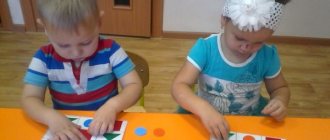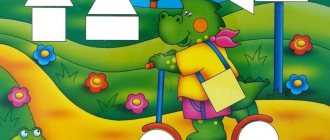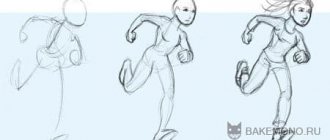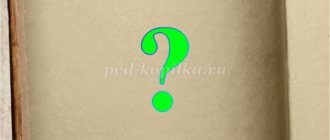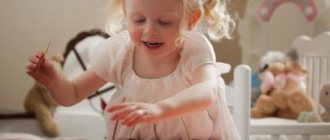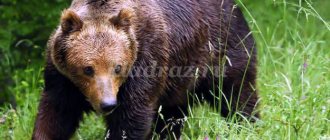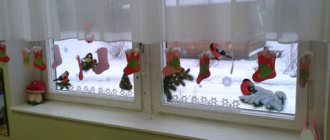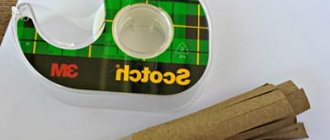Summary of an open lesson on FEMP in the first junior group “Geometric Figures”
The teacher suggests tracing a circle with your finger.
Educator: Let's look further:
- I have three tops, three corners, three sides. Who am I?
Children: Triangle.
He takes out a triangle and attaches it next to the circle: “What else did the Bunny bring us? What is the name of this figure?
The teacher invites the children to repeat the name of the figure in chorus, and for some children to show its sides and angles.
Educator: Well done! And here is another figure:
“I’m not an oval, I’m not a circle, I’m not a friend to a triangle,
This is the kind of brother I am.
And my name is...
Children: Square.
Then he takes out a square, places it next to the triangle, names the figure, shows the sides and corners of the square and asks the children: “What does a square have? How many sides does a square have? How many angles does a square have?
The teacher asks the children to circle the square and show its sides (corners).
The teacher summarizes the children's answers and actions.
part 2
. Educator: “What great fellows you all are. They correctly named all the geometric shapes that Bunny brought. I think he really enjoyed being with you, and he offers to warm up a little.
Physical school
The little gray bunny sits and wiggles his ears!
(Children squat down and use their hands to imitate how a bunny moves its ears)
Just like that, like that, and he moves his ears!
It's cold for the bunny to sit, we need to warm his little paws,
That's it, that's it, we need to warm our little paws!
(Children lightly clap palm to palm, then stand up)
It's cold for the bunny to stand, the bunny needs to jump!
Hop - hop - hop - hop, the bunny needs to jump!
(Children jump on two legs, pressing their hands to their chest)
Someone scared the bunny, the bunny jumped and ran away.
(The children scatter in all directions, and the teacher takes the fox and runs after the bunnies)
Educator: - Well done! The bunny told me that in our group there are a lot of objects that have the same shape as his gifts - a circle, a square, a triangle. And he offers to find them.
Look, under each of you there is a card with a picture of a circle, square, triangle. Take them and look at them. Then look carefully at our group and find something round, square, triangular.
(Children, in accordance with the image on the card, find the necessary objects of round, square, triangular shape.)
Educator: Well done, you also coped with this task.
Part 3.
Outdoor game "Find your house."
There is a circle, a triangle and a square on the tables. Children take one geometric figure that was under their chairs and call them the keys to the house (hoop). Children with keys go to the carpet and begin to move to the music. At the end of the melody, the teacher says that it is night and they must find their houses: those with a circle in their hands run to the circle, those with a triangle run to the triangle, those with a square run to the square. When the children take their places, the teacher asks them to justify their choice.
Mathematics lesson in 1st junior group. Circle and square
Summary of a lesson on the formation of elementary mathematical concepts in the 1st junior group.
Topic: Geometric figures: circle and square Purpose: to consolidate ideas about geometric figures - circle and square. Objectives: Educational:
- teach to recognize, distinguish and find geometric shapes: circle and square;
- learn to correlate a geometric figure with its model; - teach children to navigate in space, use prepositions -under, -for, -7na Developmental:
- develop attention;
- develop the ability to analyze and work with didactic material Educational:
- cultivate interest in joint activities with peers;
- develop a sense of community; - cultivate a sense of empathy for the characters Speech:
- development of coherent speech - teach children to answer the question “how much?”
the word "a lot"; - use of words in speech: circle, square, round shape, square shape. Preliminary work: • Reading fiction “Zayushkina’s Hut” • D/i “Geometric Figures” • Games “Fox and Hares” • Finger gymnastics “House” Developing subject-spatial environment: Dienesh blocks (circles and squares of different sizes and colors), 2 houses, pictures with square and round objects, toys: a fox and a hare, a circle and a square made of cardboard.
Progress:
Chairs on the carpet in a semicircle.
Educator: Children, sit down on the chairs. The back was straightened, the arms were placed on the knees. There's a knock on the door. Educator: Guys, who is that knocking? I'll go open the door. (I take the hare and fox toys) That's who knocked on our door! Did you find out? Children: Yes, it's the fox and the hare. Educator: Where do you think they came to us from? Children: from the forest. Educator: Do you remember the fairy tale about the fox and the hare? Children: Yes, Zayushka’s hut. The fox kicked the bunny out of the house because her hut had melted. Educator: Correct. But now the fox and the hare have become friends, the fox promised not to offend the bunny anymore. Today they came to visit us so that the children could help them build houses. Let's help the animals? Children: Yes! Educator: Let's get down to work together and build new houses for the fox and the hare. And let them “walk” around our group. Finger gymnastics All day long knock and knock - a ringing sound is heard (hands clenched into fists, thumb raised up, tapping on the index finger) Hammers knock (knock fist on fist) We build a house for the animals. This is such a good house. How wonderful we will live! (show “roof”) Educator: These are the kind of houses we got! Where are our little animals? Let's go look for them. Are they near the closet? Children: No Teacher: Is there something under the table? Children: No! Jr. At this time, the teacher scatters Dienesh blocks in the form of a path on the floor. Educator: That's where they are! They hid behind the sofa! Dana, where are the little animals hiding? Children: Behind the sofa. (I ask 3-4 children) Educator: Fox, bunny, we built houses for you, let’s go have a look. Oh, there's a blockage on our way. How will we get to the house?! To go further, we need to clear the road. Guys, these are not ordinary stones. Look what shape they are? What geometric shapes do they resemble? Children: circle and square. Educator: Well done! Let's clear the path of stones. We will put all the round pebbles on the round “stump”, and square-shaped pebbles on the square “stump”. What shape of pebble did you take? Why did you put it here? (2-3 children) Good guys, everyone did it! Because we worked together, because together it turns out faster and better: everyone managed to arrange the pebbles into shape. Look! These are houses. But they are different. What is painted on this house? Children: circle Teacher: And in the other house? Children: square Educator: How can we now understand who gets which house? Look, the animals have badges. What shape is the fox's badge? Children: square Teacher: What about the bunny? Children: round Teacher: Well done! Now we know where whose house is. Let's plant them next to our houses. Bunny, your house is round. What should we say to the fox? “Fox, your house is square.” Let's visit each other together. And you, kids, sit down on the chairs. Guys, there is nothing in the houses of the fox and the hare. How to be? We need to help them arrange their huts. Are you ready to help? Children: Yes Educator: I have pictures, but they are not simple. Some objects on them are round, and some are square. What do you think we should put in the fox’s house? What shape? Children: square Teacher: What shape of objects should we put in the house for the bunny? Children: Round. Educator: Why? Children: Because the bunny has a round icon. I suggest going to the table and taking 1 picture. Ask the children: “What is shown in the picture? What shape? Who needs to be put in the house?” Educator: Well done. You were able to determine the shape of objects in the pictures. The animals became cheerful and happy! Because their house is no longer empty, it has many items that they need every day. They thank you for their new homes, for being able to furnish them, and invite you to play with them and celebrate their housewarming. Outdoor game “Fox and Hares”
We leave the animals in the houses, say goodbye to them
Teacher, Children: Goodbye, fox and bunny! All the best to you!
We recommend watching:
Summary of GCD in the 1st junior group on FEMP “Let's treat the Bunny with a carrot” Summary of GCD in the 1st junior group on the formation of a holistic picture of the world Summary of a design lesson in the 1st junior group Summary of a lesson with children of the first junior group
Similar articles:
Summary of GCD in the 1st junior group by February 23
Lesson notes for the early childhood group in kindergarten
Lesson summary for an early age group. Cockerel
Lesson summary for an early age group. Dandelion
Summary of a game development lesson in kindergarten in the second group of early age on the topic: Toys
Card index of didactic games for FEMP 1st junior group
Card index of didactic games for FEMP
(junior group 2017-2018 academic year)
By section: quantity
1. Didactic game “Guess who is behind whom”
Target:
to form in children the idea that some objects are obscured by others. Clarify the idea that large objects obscure smaller ones, and smaller ones do not obscure larger ones; consolidate the words “more”, “less”, “before”; introduce the word “obscure”.
Equipment.
Various toys.
Content.
The toys are on the teacher’s table. He asks you to look at what is on the table and close your eyes. He takes two toys, puts them aside a little and stands up so that he obscures them with himself. The children open their eyes and discover that two toys are missing. “I didn’t leave the table. Where did the toys go? - says the teacher. If one of the children guesses, the teacher says in surprise: “Oh, I stood up and shielded them.” If the children do not find them, then he searches for them himself and, having discovered the missing toys, explains the reason for their disappearance. After this, the teacher removes the toys and invites two children to the table: one tall, large, the other small. Children are again convinced of the principle of obscurity when the little one stands behind the back of the big one. The teacher discusses the results of the game with the children, why Tanya is not visible behind Kolya, but Kolya is visible behind Tanya: “The larger one obscures the smaller one, but the smaller one cannot obscure the larger one.”
2. Didactic game “Let’s build houses”
Target:
learn to visually correlate the size of objects and check your choice by superimposing; develop attention; consolidate words that define the relativity of quantities “more”, “less”, “same”.
Equipment.
Three cardboard houses of different sizes with slots for doors and windows, without roofs; cardboard windows, doors, roofs of three sizes, corresponding to the size of the houses.
Content.
The teacher inserts large images of three houses into the typesetting canvas, placing them in random order and not in a row. The elements of houses (roofs, windows, doors) are mixed up on the table. Then he tells the children that they will be builders, they will complete houses, which should be neat and level; All parts should be selected so that they fit the required parts. The children go around and take turns “finishing” the houses. Those sitting at the table take part in the assessment of each stage of the work. At the end, the teacher sums it up: “We installed smaller doors, a smaller roof, and smaller windows for the largest house. And the smallest house has the smallest windows, the smallest door, the smallest roof.”
3. Game "Helper"
Target:
Development of fine and gross motor skills, coordination, dexterity. Instill hard work.
Equipment:
Containers with fillers, scoops, fillers.
Content:
The teacher invites the child to transfer the contents from one container to another.
By section: size
1. Didactic game “Three squares”
Target:
teach children to correlate three objects by size and indicate their relationships with the words: “big”, small”, “medium”, largest”, “smallest”.
Equipment.
Three squares of different sizes, flannelgraph; Children have 3 squares.
Content
. Educator: Children, I have 3 squares, like these (shows). This one is the biggest, this one is smaller, and this one is the smallest (each of them shows). Now show the largest squares (children pick them up and show them), put them down. Now raise the averages. Now - the smallest ones. Next, the teacher invites the children to build towers from the squares. He shows how this is done - he places first a large, then a medium, then a small square on the flannelgraph from bottom to top. “Make such a tower on your flannelographs,” says the teacher.
2. Didactic game “Wide - Narrow”
Target:
form a “broad-narrow” view.
Content.
The lesson is carried out in a similar way, but now children learn to distinguish the width of objects, i.e. wide and narrow ribbons of the same length. When creating a game situation, you can use the following game technique. Two cardboard strips are laid out on the table - wide and narrow (of the same length). A doll and a bear can walk along a wide strip (path), but only one of them can walk along a narrow strip. Or you can play the story with two cars.
3. Didactic game “Hedgehog”
Target:
learn to correlate objects by size, to identify size as a significant feature that determines actions; consolidate the meaning of the words “big”, “small”, “more”, “less”, introduce them into the children’s active vocabulary.
Equipment.
Cardboard stencils depicting hedgehogs and umbrellas of four sizes.
Content.
The teacher says that now he will tell a fairy tale about hedgehogs: “A family of hedgehogs lived in the forest: dad, mom and two hedgehogs. One day the hedgehogs went for a walk and went out into the field. There was neither a house nor a tree there (Invites the children to find hedgehog figures on trays and put them in front of them. He approaches each one and places the figures in a row according to size). Suddenly daddy the hedgehog said: “Look how big the cloud is. It's going to rain now." “Let’s run into the forest,” suggested the hedgehog’s mother. “Let’s hide under the tree.” But then it started to rain, and the hedgehogs did not have time to hide. You guys have umbrellas. Help the hedgehogs, give them umbrellas. Just look carefully at which umbrella is suitable for whom. (See if children use the principle of comparing objects by size.) “Well done, now all the hedgehogs are hiding under umbrellas. And they thank you." The teacher asks someone why he gave one umbrella to daddy the hedgehog and another to mommy hedgehog; next child - why did he give the little hedgehogs different umbrellas? Children answer, and the teacher helps them formulate the answer correctly.
By section: form
1. Didactic game “Pick a figure”
Target:
consolidate children’s ideas about geometric shapes and practice naming them.
Equipment.
Demonstration: circle, square, triangle, cut out of cardboard, cards with outlines of 3 geometric lottos.
Content.
The teacher shows the children the figures, traces each with a finger. Gives the children a task: “You have cards on your tables with figures of different shapes on them, and the same figures on trays. Place all the figures on the cards so that they are hidden.” Asks the children to trace each figure lying on the tray, and then places (“hide”) it on the drawn figure.
2. Didactic game “Make an object”
Target:
practice composing the silhouette of an object from individual parts (geometric shapes).
Equipment.
On the teacher’s table there are large toys: a house, a tumbler, a snowman, a Christmas tree, a truck. There are sets of different geometric shapes on the floor.
Content.
The teacher offers to name the toys that are on his table and make any of them using a set of geometric shapes. Encourages and stimulates children's actions. He asks: “What did you make up? From what geometric shapes?” Children examine the resulting silhouettes of toys, remember the corresponding poems and riddles. It is possible to combine the composed silhouettes into a single plot: “House in the Forest”, “Winter Walk”, “Street”
3. Didactic game “Mailbox”
Target:
to learn to see the shape in an object, to correlate the shape of the slot and the tab, to compose a whole from different geometric shapes and their parts, selecting the ones you need through testing and trying on.
Equipment.
Boards with slots for laying out shapes, identical in color, but different in configuration, with the image of a ball, a balloon (from two semi-ovals), a two-story house (from two rectangles); figures (two semicircles of different colors, two semi-ovals of the same color, two rectangles).
Content.
Mixed boards and figures are placed in front of the child. The teacher asks the child to compose all the pictures, and then say which image he got.
4. Didactic game “Search and Find”
Target:
learn to find objects of different shapes in a room by word name; develop attention and memory.
Content.
The teacher lays out toys of different shapes in different places in the group room in advance and says: “We will look for round-shaped objects. Find everything that is round in our room and bring it to my table.” The children disperse, the teacher provides assistance to those who are having difficulty. Children bring objects, put them on the teacher’s table, sit down. The teacher examines the objects they brought with them, evaluates the result of completing the task. The game is repeated, children look for objects of a different shape.
By section: spatial orientation
1. Game “Right as Left”
Target:
mastering the ability to navigate on a sheet of paper.
Content.
The nesting dolls were in a hurry and forgot to complete their drawings. You need to finish drawing them so that one half is similar to the other. The children draw, and the adult says: “Dot, dot, two hooks, minus a comma - it’s a funny face.” And if there is a bow and a little skirt, the man is a girl. And if he has a forelock and shorts, that little man is a boy.” Children look at the drawings."
2. Didactic game “Let’s decorate the scarf”
Target:
learn to compare two equal and unequal in quantity groups of objects, practice orientation on a plane.
Equipment:
“scarves” (large for the teacher, small for the children), a set of leaves of two colors (for each child).
Content.
The teacher suggests decorating the scarves with leaves. He asks how this can be done (each child completes the task independently). Then he says: “Now let’s decorate the handkerchiefs differently, everything is the same. I will decorate my scarf, and you will decorate the little ones. Decorate the top edge with yellow leaves, like this. (Shows). Put as many leaves as I did. With your right hand, arrange them in a row from left to right. And we will decorate the bottom edge of the scarf with green leaves. Let's take as many green leaves as yellow ones. Add another yellow leaf and place it on the top edge of the scarf. Which leaves have increased in number? How can we make them equal?” After checking the work and evaluating it, the teacher suggests decorating the left and right sides of the scarf with leaves of different colors. Place as many leaves on the right side of the scarf as on the left. (Shows). In conclusion, the children decorate all sides of the scarf in their own way and talk about it.
3. Didactic game “Painting”
Target:
learn to place objects on a sheet of paper (top, bottom, sides); develop attention, imitation; consolidate the perception of holistic objects and distinguish them from each other.
Equipment.
A large sheet of paper for the panel, large applique details (sun, strip of land, house, figurine of a boy or girl, tree, bird), sheets of paper, the same small applique elements, trays, glue, tassels, oilcloths, rags according to the number of children.
Content.
The teacher tells the children that they will make a beautiful picture: he will do it on a large sheet of paper attached to the board, and they will do small ones on their own sheets of paper. You just need to watch carefully and do everything as the teacher does. Then the teacher distributes material for the application to the children. First, he sticks a strip of earth at the bottom and the sun at the top. The teacher does everything slowly, recording his actions at every moment and giving the children the opportunity to choose each element and place it correctly on paper. If necessary, helps the child determine the place on a piece of paper (top, bottom). Upon completion, the teacher compares the children’s work with his own, discussing the spatial arrangement of objects, praises them, causing a positive attitude towards the result of the work. Then he briefly describes the content of the resulting image, fixing the spatial arrangement of objects: “The boy went out into the street. I looked - the earth was below, the sky was above. The sun is in the sky. Below, on the ground, is a house and a tree. The boy is standing near the house on one side, and the tree is on the other side. A bird is sitting on a tree."
4
